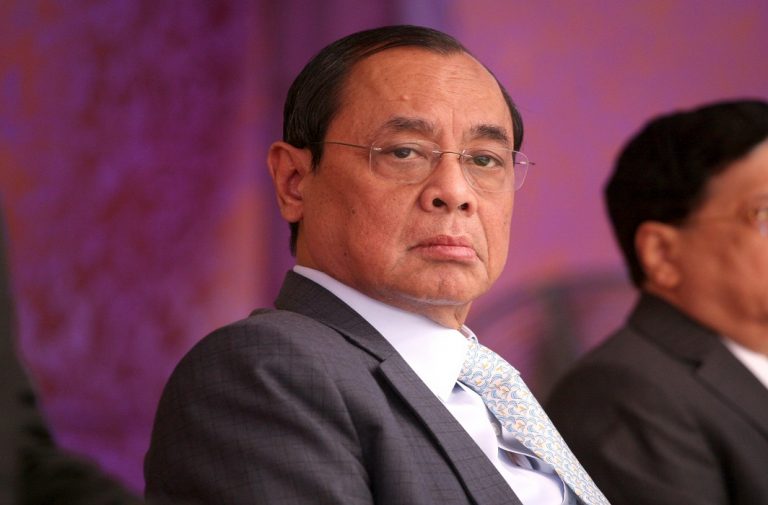
Above: CJI Ranjan Gogoi/Photo: Anil Shakya
Ranjan Gogoi’s outburst over a “leak” of confidential details in CBI director Alok Verma’s case runs counter to his earlier assertion of the need for “noisy journalists” to protect democracy
By India Legal Bureau
The week gone by saw an uncharacteristic, even misdirected, outburst by Chief Justice Ranjan Gogoi as a Supreme Court bench headed by him heard a petition filed by CBI chief Alok Verma. Visibly upset over the “leak” of confidential details pertaining to the case, the chief justice wrapped up the proceedings on November 20 in a matter of minutes after asserting that the parties in the case “do not deserve any hearing”.
Adjourning the case till November 29, CJI Gogoi made his displeasure known to Verma’s counsel, senior advocate Fali Nariman, about the purported leak of the CBI chief’s response to the Central Vigilance Commission’s (CVC) inquiry report against his alleged corruption and professional misconduct.
The other trigger for the CJI’s fury was a request by advocate Gopal Sankaranarayanan to the bench a day prior. Appearing for Verma before the bench, also comprising Justices SK Kaul and KM Joseph, on November 19, Sankaranarayanan had sought an extension of the deadline given to the CBI director to file his reply with the Court to the CVC’s findings.
Shortly after the case was adjourned, the CJI allowed Nariman to offer his clarification on the issues that had riled the Court. And it turned out that the “leak” was more a case of “much ado about nothing”. Sankaranarayanan’s appearance was a classic example of how litigants (Verma, in this case) must be extra cautious in handling their legal battles, especially ones where they have an edge, and it wasn’t surprising that the CJI attributed the mess to the “inefficiency of counsel”.
Handing a copy of an article published by news portal The Wire to Nariman, Chief Justice Gogoi said: “We expressed that highest degree of confidentiality must be maintained and this litigant (the CBI director) takes the papers and shares them with everyone. Our respect for this institution is not shared by anyone.”
Earlier in the day, when the bench had first assembled to hear the case, Nariman had told the CJI that the purported leaks had not been authorised by him or anyone in Verma’s legal team.
The article published by The Wire was about Verma’s response to a questionnaire that the CVC had sent to him during the two-week apex court-mandated period of the inquiry against him, which was being supervised by retired Supreme Court judge Justice AK Patnaik. This inquiry had ended on November 10 and its report was filed with the Supreme Court’s registry on November 12 in a sealed envelope. The order of the apex court to maintain confidentiality (read: file in sealed covers) was given in relation to this report. Subsequently, on November 16, Verma’s response to the inquiry’s findings was filed in a sealed envelope on November 19.
The corridors of the Supreme Court are still abuzz with questions on why the CVC’s report should have been delivered under sealed cover (were national security secrets involved?), and why the “service related matter” regarding the summary removal of Verma without recourse to due process could not have been taken up separately from the charges and counter charges of corruption within the CBI. But this is a different debate altogether.
Nariman pointed out to the CJI that the confidentiality order did not apply to Verma’s response to the CVC during the course of the inquiry. The CJI said nothing to this submission, but expressed further displeasure over the publication of new allegations made in a petition filed before the Court by CBI officer MK Sinha.
Sinha’s petition has levelled serious allegations against National Security Adviser Ajit Doval (of stymieing the Agency’s probe against its special director, Rakesh Asthana), Union minister Haribhai Chaudhary (of being paid bribes by Hyderabad-based businessman Sathish Sana), and other senior government officials. Sinha was part of the CBI team that was probing the corruption cases against Asthana. He was transferred to Nagpur by the Agency’s interim chief, M Nageswara Rao, soon after the government on October 24 divested Verma and Asthana of their respective responsibilities.
Sinha’s petition—though its contents have the potential of undermining the CBI, the CVC and even the Prime Minister’s Office—has not yet been heard by the top court, and so, there is no bar on its publication.
It is evident that none of what the Supreme Court had deemed “confidential” in Verma’s case has come into the public domain, so far, by way of news reports. So the CJI’s outburst was surprising. Editors and veteran journalists were quick to comment that journalism thrives on investigative stories and leaks, not just in India, but globally. The Indian Express, through an editorial, sought to remind Chief Justice Gogoi, “with due respect”, of a rousing speech he had delivered this year during the Ramnath Goenka Memorial Lecture. He (hadn’t been elevated as CJI then) had quoted an article published by The Economist which said that “independent judges and noisy journalists are democracy’s first line of defence”.
It is difficult to reconcile this address with the chief justice’s recent outburst against an article that many believe was responsible reportage. It was not too long ago that Gogoi broke established traditions to participate in the famous “judges’ press conference” and hit out at the then chief justice in an ostensible bid to protect one pillar of democracy—the judiciary.

